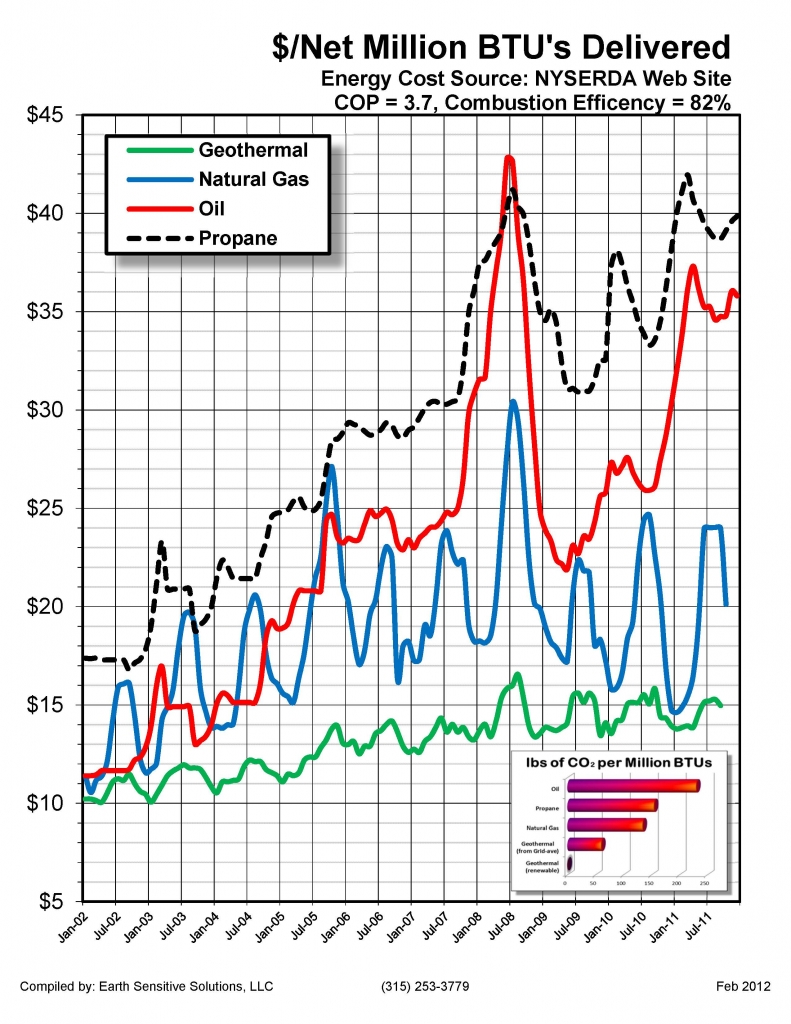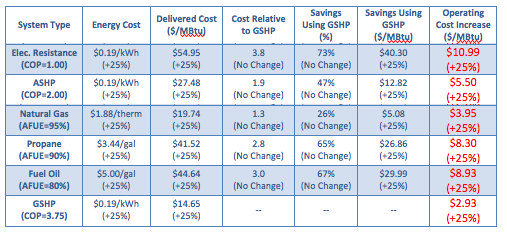Those of us in the ground source heat pump (GSHP) industry already know of the many benefits that these systems hold over conventional heating and cooling systems (and have probably explained them a hundred times over). But as the appeal of geothermal technology shifts to the masses, we must find ways to relate to everyday consumers through metrics such as return on investment, life cycle cost and the like.
When it comes time to give the sales pitch, economics can be a very powerful tool. How many of you have ever made the case for a GSHP system from the standpoint of hedging against inflationary energy prices? In this article we intend to show that when energy prices rise, it actually gets easier to justify an investment in a GSHP system.
First, A Little Ground-Work
In order to make this case, some calculations will be required. The simplest way to compare the cost of heating with a given fuel source is to calculate the cost to deliver a fixed amount of energy to a space. For the purpose of illustration, we will calculate the cost to deliver 1,000,000 Btu’s of heating energy (1 MBtu) using the following equation:
Before getting started, we need to know a few things, such as the amount of energy contained in a given amount of electricity, natural gas, propane and heating oil:
Fuel Type vs. Energy Content (HHV, Higher Heating Value)
|
Fuel Type |
HHV |
Units |
|
Electricity |
3,412 |
Btu per kWh |
|
Natural Gas |
100,000 |
Btu per therm |
|
Propane |
92,000 |
Btu per gallon |
|
Fuel Oil |
140,000 |
Btu per gallon |
We also need to know the efficiency of each system and the price we’ll pay for fuel:
Assumed Energy Prices & Efficiencies
|
System Type |
Fuel |
Energy Price |
Efficiency |
|
Electric Resistance |
Electricity |
$0.15/kWh |
COP = 1.00 |
|
ASHP+ |
Electricity |
$0.15/kWh |
COP = 2.00++ |
|
GSHP |
Electricity |
$0.15/kWh |
COP = 3.75 |
|
Furnace or Boiler |
Natural Gas |
$1.50/therm |
AFUE = 95% |
|
Furnace or Boiler |
Propane |
$2.75/gal |
AFUE = 90% |
|
Furnace or Boiler |
Fuel Oil |
$4.00/gal |
AFUE = 80% |
+ASHP – Air Source Heat Pump
++Equivalent to a Heating Seasonal Performance Factor (HSPF) value of 6.8 for ASHP’s
The Calculations
Now that we have all of the necessary information, we can get started with the calculations. For example, the cost to deliver 1 MBtu with natural gas is calculated as follows:
The results of the calculations for each system are summarized in the illustration and table below:
Direct Heating Cost Comparisons
|
System Type |
Energy Cost |
Delivered Cost ($/MBtu) |
Cost Relative to GSHP |
Savings Using GSHP (%) |
Savings Using GSHP ($/MBtu) |
|
Elec. Resistance (COP=1.00) |
$0.15/kWh |
$43.96 |
3.8 |
73% |
$32.24 |
|
ASHP (COP=2.00) |
$0.15/kWh |
$21.98 |
1.9 |
47% |
$10.26 |
|
Natural Gas (AFUE=95%) |
$1.50/therm |
$15.79 |
1.3 |
26% |
$4.07 |
|
Propane (AFUE=90%) |
$2.75/gal |
$33.21 |
2.8 |
65% |
$21.49 |
|
Fuel Oil (AFUE=80%) |
$4.00/gal |
$35.71 |
3.0 |
67% |
$23.99 |
|
GSHP (COP=3.75) |
$0.15/kWh |
$11.72 |
— |
— |
— |
Note that we also calculated the cost relative to heating with a GSHP system (because it is the cheapest method) and the savings associated with the GSHP itself. For example, the table shows that heating with the propane-fired furnace while paying $2.75 per gallon is almost three times as expensive as heating with a GSHP system (actually, 2.8x). Furthermore, a GSHP system would save about 65% per year in heating costs (or $21.49 per MBtu’s of heating energy delivered) over the propane system, based on our assumptions.
Through this example, we’ve already made a pretty strong case for the GSHP over a propane-fired furnace or boiler. But so far, we’ve only looked at today’s prices without any real consideration to the future. To show how GSHPs act as a hedge against rising energy prices, we performed the same calculations after an assumed 25% increase in ALL energy prices:
Direct Heating Cost Comparisons (After 25% Increase)
Returning to the example of the propane system, after a 25% increase in energy prices, it is still almost three times as expensive to heat with propane compared to the GSHP system. Additionally, the GSHP system still saves about 65% in annual heating costs. However, because the numbers are larger, the savings are more significant.
Compared to propane, the GSHP system saves $26.86 per MBtu of heating energy delivered (compared to $21.49 per MBtu in the previous example). As shown in the table, the 25% increase in energy prices leads to a $8.30/MBtu increase in the cost of heating with propane compared to a $2.93/MBtu increase in heating with the GSHP system.
The Big Picture
Hopefully, the results of these calculations drive home two main points. The first point is that heating costs and the savings associated with a GSHP system are relative to energy prices. As the prices of natural gas, propane, and heating oil increase with respect to the price of electricity, GSHPs look more attractive. Historically, the rise in electricity prices has been slow but steady while natural gas, propane, and heating oil prices tend to be more volatile.
The second point is that GSHP systems do act as a safeguard against increasing energy prices by virtue of how a GSHP works. Only about one-third to one-fourth of the energy delivered in heating with a GSHP comes from electricity consumption, the rest is extracted from the Earth. ALL of the energy delivered with a combustion-based heating system comes from the consumption of a fuel source whether it is natural gas, propane or heating oil. To put it simply, a 50% increase in a small number makes a much smaller impact than a 50% increase in a large number.
One Final Thought
Keep in mind that our calculations were based on the cost to deliver 1 MBtu to a space. In reality, 1 MBtu isn’t that much energy. It would probably be more useful to know how much energy it actually takes to heat your home.
We decided to estimate the heating load and associated energy requirements for a 1,500 ft2 home (on the main level) with fully conditioned basement (assuming average construction: R-19 walls, R-20 ceiling and average tightness levels). The table below will give you an idea of how much energy it actually takes to heat a home of this size and construction for a year:
+Approximate Heating Energy Requirements vs. Location (1,500 ft2 Home):
|
City |
Heat Energy Required+ |
City |
Heat Energy Required + |
|
Atlanta, GA |
26 MBtu |
Indianapolis, IN |
56 MBtu |
|
Augusta, ME |
74 MBtu |
Knoxville, TN |
37 MBtu |
|
Billings, MT |
69 MBtu |
Pittsburgh, PA |
57 MBtu |
|
Boston, MA |
63 MBtu |
Reno, NV |
56 MBtu |
|
Brookings, SD |
76 MBtu |
Richmond, VA |
37 MBtu |
|
Charlotte, NC |
32 MBtu |
Sacramento, CA |
25 MBtu |
|
Chicago, IL |
62 MBtu |
Salk Lake City, UT |
57 MBtu |
|
Cleveland, OH |
60 MBtu |
Seattle, WA |
55 MBtu |
|
Dallas, TX |
24 MBtu |
Tulsa, OK |
37 MBtu |
|
Denver, CO |
58 MBtu |
Witchita, KS |
51 Mbtu |
|
Des Moines, IA |
66 MBtu |
Detroit, MI |
66 MBtu |
+LoopLink Load Estimator was used to estimate peak heating loads and energy requirements for the home in each location
By taking the information from this table and applying it to the Direct Heating Cost Comparison tables, you can easily figure out what your approximate heating costs would actually be. For example, if your home is located in Brookings, SD and you wanted to know the cost to heat your home with a GSHP using $0.15/kWh electricity:
After the 25% Increase in Prices…
It is hard to predict what the future will bring. Energy prices rise and fall but the general trend is upward. One major advantage of GSHP systems that is often overlooked is their power to act as a safeguard against rising energy prices. It is relatively easy to show that as energy prices go up, GSHP systems become more and more economically attractive while retaining all of the other benefits. It’s not likely that this point alone will sell the system for you; it’s just another tool for the arsenal.
Post Updates.
This post has received a great response from many people in the industry and I hope some can use the argument to improve their sales.
John Manning From Phoenix Energy Supply sent in this graph of real data captured by NYSERDA over the past 10 years.
 Also, one of readers wrote in with this question:
Also, one of readers wrote in with this question:
Chris, my only issues with your graph is that we are installing air source heat pumps with an HSPF of 12-12.5, and SEER rating up to 27.2. These would be as or more efficient then a GSHP.
Ryan Carda responded with the following response:
Two things to remember with air-source equipment:
1) The SEER and HSPF ratings are based on tests done in a factory setting with mild outdoor air temperatures:
a. They do not account for coil degradation over time
b. They do not account for the defrost cycle or supplemental heat in the winter
2) According to ASHRAE, the service life for ASHP equipment is 12 years whereas the service life for GSHP equipment is 25 years.
a. On average, you will purchase two ASHPs to every GSHP unit.
This ASHRAE publication gives guidelines for how to adjust the performance of air-source equipment to more closely model it based on actual operating conditions. When applying the adjustment suggested in this publication to the Fujistu equipment, you will come up these suggested ratings:
- · HSPF = 6.48 (equivalent to a COP of 1.90)
- · SEER = 22.1
These adjustments were based on the 27.2 SEER and 12.5 HSPF values given in the brochure for the design OATs of -3F in heating and 87F in cooling for Augusta, ME.
For the same location, using LoopLink to perform a closed-loop GHEX design using temperatures of 30F (min EWT) in heating and 70 (max EWT) in cooling, I calculate an average COP of 3.90 during the heating season to go along with an average EER of 30 during the cooling season. In my example project, I used the performance of a Waterfurnace ND038 as the basis for comparison.








[…] comes from the consumption of a fuel source whether it is natural gas, propane or heating oil…read more This entry was posted in Uncategorized. Bookmark the […]
[…] There is no sense reinventing the wheel, so to see a good example of how to calculate the cost of a geothermal BTU vs a comparable, see Ryan Carda’s article “Selling Geothermal As a Hedge Against Rising Energy Prices” […]